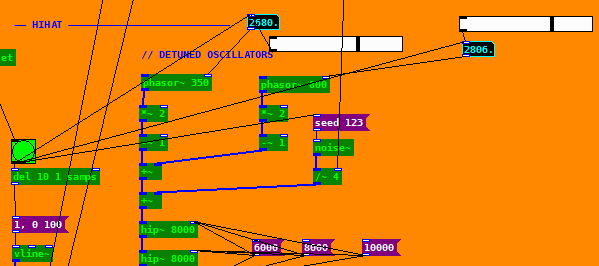Signature
-
 seb-harmonik.ar
posted in technical issues • read more
seb-harmonik.ar
posted in technical issues • read morewell feel free to copy it if you want.. else has a far more steady release schedule anyways

-
 seb-harmonik.ar
posted in technical issues • read more
seb-harmonik.ar
posted in technical issues • read more@porres I think I implemented it after reading about the algorithm
the fundamental preserves the 'residual' phase when it the cycle completes, and at that point the center frequency phase is reset to 0the frequencies can only be updated when fundamental or center frequency phase rolls over (or they are already 0)
it checks to see if there's enough 'space' in the fundamental phase to fit another center frequency cycle (that's the
phsinc = outfreq/infreq; routphase = shadylib_min(1.f - phsinc, duty); routphase = routphase - outphase - res;part)
but does so while considering the phase it had wrapped around at the beginning of this cycle ('res')This was to avoid the last cycle of the center frequency from popping in and out depending on the starting phase of the fundamental
-
 seb-harmonik.ar
posted in technical issues • read more
seb-harmonik.ar
posted in technical issues • read more@jamcultur shadylib is on deken and there is a windows version https://deken.puredata.info/search.html?libraries=shadylib&objects=&descriptions=
It has not had a 'release' in 5 years despite 94 commits.. maybe should get on that
although I think the only changes in voisim~ were some minor possible performance improvements
-
 seb-harmonik.ar
posted in technical issues • read more
seb-harmonik.ar
posted in technical issues • read more@cfry it probably picked up [list-dripdex] which is
[list-drip]w/ index
I think list-abs could use a rewrite using the 'new'[list]objects..
I recommend just installing zexy and using[drip]though.. externals will always be faster than abstractions -
-
 seb-harmonik.ar
posted in technical issues • read more
seb-harmonik.ar
posted in technical issues • read more@Konked2 maybe make an attack part of the envelope.. right now it jumps up to one instantly
@lacuna good call, forgot about clear
-
 seb-harmonik.ar
posted in technical issues • read more
seb-harmonik.ar
posted in technical issues • read more@Konked2 hmm.. maybe you're still missing something? here's the edited patch
or maybe there is inconsistency and my speakers aren't good enough to tell
picodrumz.pd -
 seb-harmonik.ar
posted in technical issues • read more
seb-harmonik.ar
posted in technical issues • read more@Konked2 you have to connect the
[del]to the message box that is going into[vline~]
also maybe you made a message[del(instead of an object[del]? -
 seb-harmonik.ar
posted in technical issues • read more
seb-harmonik.ar
posted in technical issues • read moreThanks David
I think it's due to the value of the noise~ and phasor phase
Try this to fix:

you can use the [seed (message to noise~ to set a consistent set of samples from it
but, the state in the filters has to 'settle' after that, hence the[del]
but [line~] can't begin 10 samples after the block starts so[vline~]must be usededit: actually I think 3 samples is enough delay.. 1 for each filter
not sure what the deal is on those number boxes for phase.. range should be 0-1.. -
 seb-harmonik.ar
posted in technical issues • read more
seb-harmonik.ar
posted in technical issues • read moreI didn't open the patch, but you don't want to multiply audio using message-rate ramp (from regular
[line])
use[line~]instead
edit: I noticed you're also setting a[*~ ]from a[/ 2](from the[snapshot~]) every 50 ms. That's probably also doing some popping. Maybe a[line~]over 50 ms instead would be appropriate? not exactly sure of the intent there
